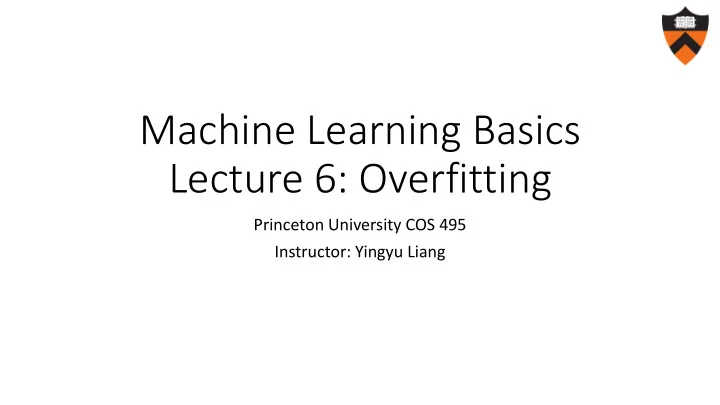

Machine Learning Basics Lecture 6: Overfitting Princeton University COS 495 Instructor: Yingyu Liang
Review: machine learning basics
Math formulation • Given training data 𝑦 𝑗 , 𝑧 𝑗 : 1 ≤ 𝑗 ≤ 𝑜 i.i.d. from distribution 𝐸 1 • Find 𝑧 = 𝑔(𝑦) ∈ 𝓘 that minimizes 𝑜 𝑜 σ 𝑗=1 𝑀 𝑔 = 𝑚(𝑔, 𝑦 𝑗 , 𝑧 𝑗 ) • s.t. the expected loss is small 𝑀 𝑔 = 𝔽 𝑦,𝑧 ~𝐸 [𝑚(𝑔, 𝑦, 𝑧)]
Machine learning 1-2-3 • Collect data and extract features • Build model: choose hypothesis class 𝓘 and loss function 𝑚 • Optimization: minimize the empirical loss
Feature mapping Machine learning 1-2-3 Maximum Likelihood • Collect data and extract features • Build model: choose hypothesis class 𝓘 and loss function 𝑚 • Optimization: minimize the empirical loss Occam’s razor Gradient descent; convex optimization
Overfitting
Linear vs nonlinear models 2 𝑦 1 2 𝑦 2 𝑦 1 2𝑦 1 𝑦 2 𝑧 = sign(𝑥 𝑈 𝜚(𝑦) + 𝑐) 2𝑑𝑦 1 𝑦 2 2𝑑𝑦 2 𝑑 Polynomial kernel
Linear vs nonlinear models • Linear model: 𝑔 𝑦 = 𝑏 0 + 𝑏 1 𝑦 • Nonlinear model: 𝑔 𝑦 = 𝑏 0 + 𝑏 1 𝑦 + 𝑏 2 𝑦 2 + 𝑏 3 𝑦 3 + … + 𝑏 𝑁 𝑦 𝑁 • Linear model ⊆ Nonlinear model (since can always set 𝑏 𝑗 = 0 (𝑗 > 1) ) • Looks like nonlinear model can always achieve same/smaller error • Why one use Occam’s razor (choose a smaller hypothesis class)?
Example: regression using polynomial curve 𝑢 = sin 2𝜌𝑦 + 𝜗 Figure from Machine Learning and Pattern Recognition , Bishop
Example: regression using polynomial curve 𝑢 = sin 2𝜌𝑦 + 𝜗 Regression using polynomial of degree M Figure from Machine Learning and Pattern Recognition , Bishop
Example: regression using polynomial curve 𝑢 = sin 2𝜌𝑦 + 𝜗 Figure from Machine Learning and Pattern Recognition , Bishop
Example: regression using polynomial curve 𝑢 = sin 2𝜌𝑦 + 𝜗 Figure from Machine Learning and Pattern Recognition , Bishop
Example: regression using polynomial curve 𝑢 = sin 2𝜌𝑦 + 𝜗 Figure from Machine Learning and Pattern Recognition , Bishop
Example: regression using polynomial curve Figure from Machine Learning and Pattern Recognition , Bishop
Prevent overfitting • Empirical loss and expected loss are different • Also called training error and test/generalization error • Larger the data set, smaller the difference between the two • Larger the hypothesis class, easier to find a hypothesis that fits the difference between the two • Thus has small training error but large test error (overfitting) • Larger data set helps! • Throwing away useless hypotheses also helps!
Prevent overfitting • Empirical loss and expected loss are different • Also called training error and test error • Larger the hypothesis class, easier to find a hypothesis that fits the difference between the two Use prior knowledge/model to • Thus has small training error but large test error (overfitting) prune hypotheses • Larger the data set, smaller the difference between the two • Throwing away useless hypotheses also helps! Use experience/data to • Larger data set helps! prune hypotheses
Prior v.s. data
Prior vs experience • Super strong prior knowledge: 𝓘 = {𝑔 ∗ } • No data is needed! 𝑔 ∗ : the best function
Prior vs experience • Super strong prior knowledge: 𝓘 = {𝑔 ∗ , 𝑔 1 } • A few data points suffices to detect 𝑔 ∗ 𝑔 ∗ : the best function
Prior vs experience • Super larger data set: infinite data • Hypothesis class 𝓘 can be all functions! 𝑔 ∗ : the best function
Prior vs experience • Practical scenarios: finite data, 𝓘 of median capacity, 𝑔 ∗ in/not in 𝓘 𝓘 1 𝓘 2 𝑔 ∗ : the best function
Prior vs experience • Practical scenarios lie between the two extreme cases 𝓘 = {𝑔 ∗ } practice Infinite data
General Phenomenon Figure from Deep Learning , Goodfellow, Bengio and Courville
Cross validation
Model selection • How to choose the optimal capacity? • e.g., choose the best degree for polynomial curve fitting • Cannot be done by training data alone • Create held-out data to approx. the test error • Called validation data set
Model selection: cross validation • Partition the training data into several groups • Each time use one group as validation set Figure from Machine Learning and Pattern Recognition , Bishop
Model selection: cross validation • Also used for selecting other hyper-parameters for model/algorithm • E.g., learning rate, stopping criterion of SGD, etc. • Pros: general, simple • Cons: computationally expensive; even worse when there are more hyper-parameters
Recommend
More recommend